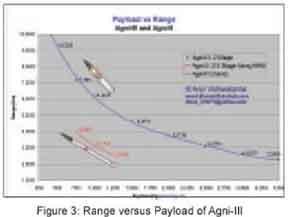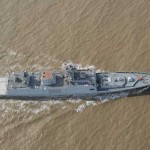Agni-III Range vs Payload
Missile range & payload mass are inversely related. It is useful to contrast the variation between Agni-III and Agni-II. It is interesting to note that Agni-III with its larger mass fraction design has a greater capability and sensitivity for lighter payload, whereas Agni-III is not very sensitive for lighter payload. Of course Agni-III is a heavier missile compared to Agni-II that offers a broader payload range.
Sources & References
1. Evaluating India’s land-based Missile Deterrent. Indian Defense Review Vol-19(4) Oct-Dec 2004, ISSN 0970-2512, Arun Vishwakarma, Dr Sanjay Badri Maharaj. Lancer Publishers & Distributors, New Delhi.
2. Raj Chengappa, Weapons of Peace: The Secret Story of India’s Quest to be a Nuclear Power (New Delhi: Harper Collins Publishers India, 2000, ISBN 81-7223-332-0).
3. Defence Research & Development Organisation (www.drdo.com)
4. DRDO periodicals “Technology Focus” bi-weekly (www.drdo.com/pub/techfocus/welcome3.htm)
5. Indian Defence Technology: Missile Systems (DRDO, Ministry of Defence, December 1998).
6. Nuclear Threat Initiative (www.nti.org)
7. http://www.nbr.org/publications/analysis/pdf/vol13no3.pdf VOLUME 13, NUMBER 3, JUNE 2002. “Ballistic Missiles and Missile Defense in Asia”
8. Nuclear Weapon Archive, ‘India’s Nuclear Weapons Program: Present Capabilities’ http://nuclearweaponarchive.org/India/IndiaArsenal.html
Notes
1. Agni 3 test launch likely by year end, Deccan Herald July 04,2005
2. ‘India ready to test fifann re an advanced 3000 Km Agni III missile in the next six months – hypersonic missiles getting developed’ India Ddaily May 17, 2005
3. “India will test-fire longest range missile: Natrajan” NEW DELHI, outlookindia.com MAY 17 2005 (PTI)
4. Also “India’s Agni III will span 3,000 km” PTI. Times Of India, MAY 17, 2005
5. Agni-III missile to be test-fired by year-end. The Hindu, 30 March 2005.
6. India Readies for Agni III Launch, Agni III ready for tests, although schedule still in flux, Aviation Week & Space Technology, 02/13/2006.
7. Agni-III ready to go, DRDO awaits govt nod EXPRESS NEWS SERVICE May 15, 200a 6
8. Agni-III can lift off in 2-3 weeks Rajat Pandit, TIMES NEWS NETWORK May 15, 2006
9. Agni-III ballistic missile ready for launch, HindustanTimes.com February 3, 2006
10. ‘India has tech to go beyond Agni-III’, Our Bureau, Hyderabad The Hindu Business Line, May 20, 2005
11. http://www.blonnet.com/2005/05/20/stories/2005052002820300.htm ”It would have a total of three test flights, including one with the user. It can carry a payload (warhead both conventional and nuclear) of 1-1.2 tonnes.”
12 . Agni-III to be test fired by year-end. Deccan Chronicle, 30 March 2005. “…capacity to carry conventional as well as nuclear warheads of over 1,500 kg.”
13 .India Cancels Agni III Test, UPI-Washington, May 31, 2006, “The Agni III is said to be able to deliver a 440-pound to 550-pound warhead with a high degree of accuracy.” http://www.spacewar.com/reports/India_Cancels_Agni_III_Test.html
14 . The ballistic coefficient ² is a measurement of an object’s ability to move through a fluid. It takes into account the effects of an object’s density and its skin friction, and is expressed as: ² = m * CD / A where m: mass, CD: coefficient of drag, A: area.
15. This was an issue with the earlier RV Mk-2 design. The older Mk-2 with its blunt nose is an all range RV, however for lighter payload its ² is relatively low, thus slowing down the RV at the fag end of its trajectory.
16. A young achiever T.S. SUBRAMANIAN, Frontline Volume 22 - Issue 20, Sep. 24 - Oct. 07, 2005 “Metal made the heat shield heavy, so the weaving and winding of the carbon- fibre around the shield was a demanding but necessary task to lighten it..”.
17. ibid
18. Composites: Use in saucepan handles, artificial limbs and the AGNI CURRENT SCIENCE, VOL. 86, NO. 3, 10 FEBRUARY 2004 http://www.ias.ac.in/currsci/feb102004/372.pdf “India has developed propulsion and re-entry systems of aerospace vehicles that need to operate in high temperature regimes such as 3000–5000°C and meet the aero thermal environment of re-entry. Scientists have successfully flight-tested the unique all-carbon composite re-entry heat shield with multi-directional carbon–carbon re-entry nose tip and control surfaces in the AGNI missile systems.”
19. A success story T.S. SUBRAMANIAN Frontline Volume 22 - Issue 20, Sep. 24 - Oct. 07, 2005 http://www.hinduonnet.com/fline/fl2220/stories/20051007002009200.htm “The four-year-old Advanced System Laboratory in Hyderabad has contributed immensely to the success of India’s missile development programme, which has reached the intercontinental ballistic missile stage. ... The ASL has already achieved a breakthrough by developing a heat-shield made of carbon composite without any metal back-up. (The heat-shield protects the warhead and avionics from the high temperatures generated by the missile’s re-entry into the earth’s atmosphere.) “We were the first one to do the carbon composite heat-shield without any metal back-up. It has been designed, developed and flight-tested for Agni, and it is perhaps the first heat-shield of its kind in the world,”
20. Launching platforms for Project K-15. http://www.drdo.com/pub/techfocus/aug04/missile13.htm
21. High-pressure reaction control system. The Hindu Andhra Pradesh. Hyderabad News City-based firm develops critical components for Agni, GSLV
22. Trade estimate
23. ibid
24. Estimated by using Bharat-Rakshak Ballistic Rocket Simulator
25. 4 Trade estimate
26. Geometric resolution from photo evidence
27. ibid
28. “Indo-Russian tie-up on Glonass satellite system” Deccan Herald, 20 Dec 2005. http://www.deccanherald.com/deccanherald/dec202005/state1861820051219.asp
29. Indian Regional Navigation Satellite System approved, 9/5/2006






Apologies but I have stopped writing in last 8 years, to focus my energy elsewhere. After demise of Capt. Bharat Verma (owner of IDR) no one has asked me for next article.
people wait and search for your articles but this time you have not come up with anything new when we have reached Agni V stage
They are just LONG or have LONG range as-well?
What poor sense of judgement must have failed in range estimation tests please don’t make comments just for the heck of it